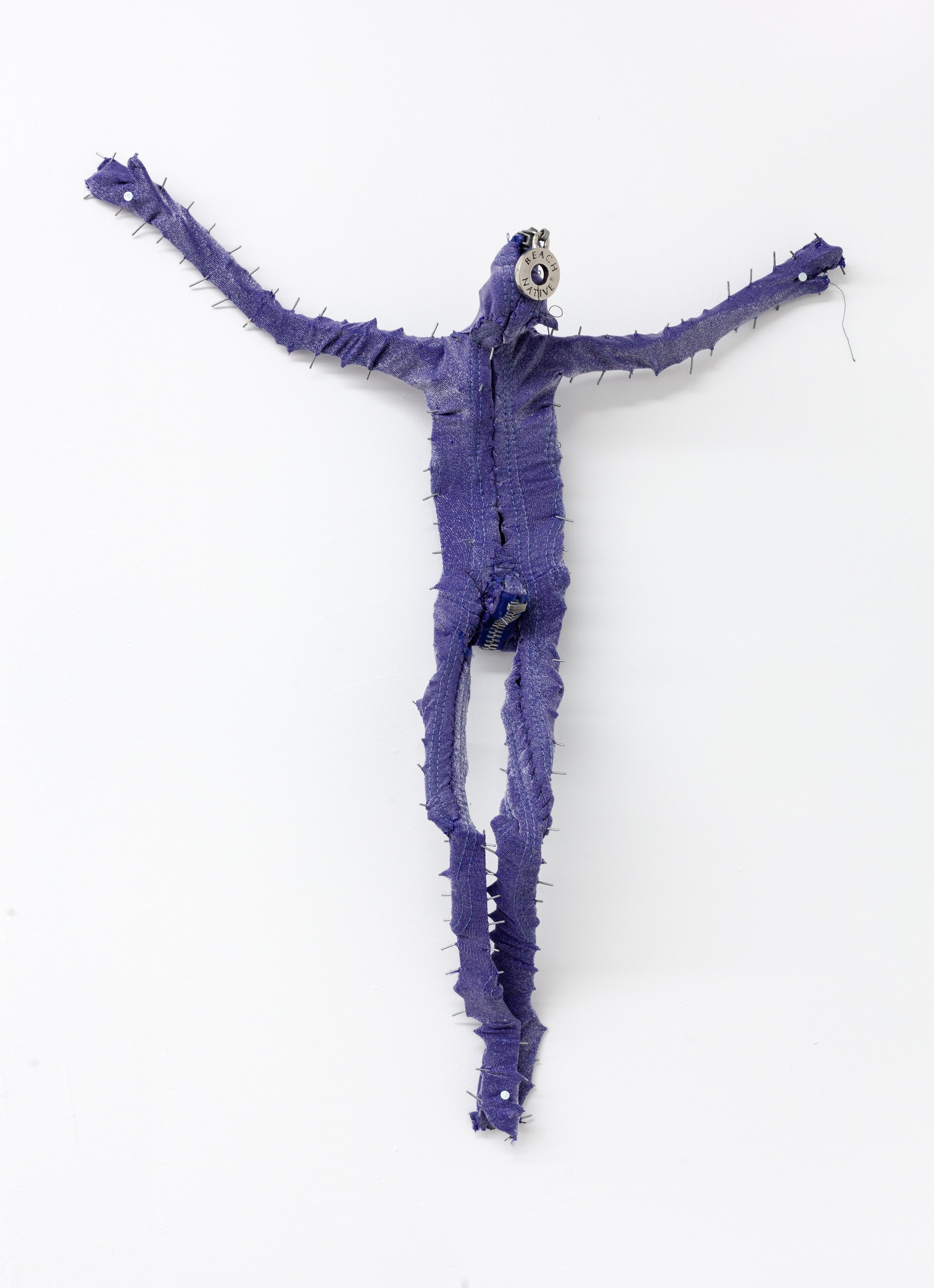Elizabeth Englander, Bikini Crucifixion no. 4, 2020. Old bathing suits, steel, cotton thread, 12 × 9 × 3.5 in. Image courtesy of the artist.
Gods at Fourteen
by Nicole Grace
Up to this point, the girls had spent their time content and whole. They swam together in the Atlantic, laughing as waves crashed over their heads. They stayed out all morning: swallowing water and spitting it out, shrieking at algae brushing at their toes, telling stories no one else could hear.
Only hunger drove them to shore. They ate burgers and ate the whole thing sitting slouched over in bikinis. For once, they did not care. They followed lunch with dinner.
They were new to the ocean—one more so than the other—and North Carolina felt like the world’s best and only paradise. They became familiar with a local turtle and named him Chancy. They memorized song lyrics and spent long showers washing sand off their bodies. They planned their futures: shared apartments and jobs, synchronized marriages and children. All with the Carolinas as a backdrop. They decided they would never leave.
With their toes on the shore of their intended home, the girls see clear across the ocean—gods at fourteen.
Two boys approach, curious if these deities might know how to have a good time. And the boys promise just that—if the girls aren’t too scared, if they can meet tomorrow. Bored of daydreaming, the girls agree and make plans.
The next day the girls sneak away from their sun-soaked and relaxing families. They are in the summer’s uniform: a white bikini for one and a blue and yellow bikini for the other, flip-flops on both their feet. On cue, the boys drive up beside them, eager to share the freedom their newly minted, out-of-state licenses provide.
Once the girls hop in, and the boys peel out, the girls begin to worry they’ve made a mistake. Left unspoken, both attempt to forget it. Plus, they think there are no mistakes to be made while with the other—and, anyway, what can truly threaten immortality?
The road is long, the windows are down, and the girls’ hair flies. The sun beats into the back seat warm and soothing. It’s all probably fine.
Elizabeth Englander, Bikini Crucifixion no. 7, 2020. Old bathing suits, steel, cotton thread, 16 × 13 × 3.5 in. Image courtesy of the artist.
When the car makes its stop, it is to pull into that classic North Carolina beach garage. One that is not really a garage, just the underneath of a house on stilts. The boys’ mother is there, or maybe just the mother of one, and she asks something like, “where were you?” or “we have plans for dinner, and we’d like you to join.” The boys, who do not introduce the girls and who likely don’t remember their names anyway, tell her to leave. She yells a little, but also she just goes into the house.
The four kids stand in a circle and pass around a dark brown liquor that the girls eventually learn is rum. Always polite, the girls take what is given, and what is given is nothing like the warm beer they tasted in the woods outside of school that one time. The girl who has been to the ocean before feels she has something to prove, and she takes the bottle again, and again, and again. She senses a soft power in each pull.
But it is a vanishing power, and, as she tries to steady herself, the boys laugh. Her knees give out, and her head hits the sand, and she’s still just in her bathing suit.
The loss of consciousness splits the girls in two, and the one left standing picks up her friend and leads her to the car, begging the boys to drive them back. The boys comply, annoyed at first, then again returning to laughter. The girl and her friend—revived in the back seat—are eventually released down shore from where their families have staked out space on the beach, from where their families have a cooler full of sandwiches labeled “PB” and “TURKEY.”
For an hour the girl takes care of her friend: explains they cannot drink ocean water, explains that there are children within hearing range, explains she loves her, too. Yes, just as much. After that hour passes, the girl holds her friend’s hand and leads her to their parents where they both sit—drinking Gatorades and drawing circles in the sand—as beach supplies get packed up around them.
The next day, the girls wake in their shared bunk bed, each looking at the other and listening for footsteps or soft voices downstairs. The girls’ faces are a silent code to each other: one pair of eyes shifts suddenly from fear to twinkling playfulness, and the other pair of eyes starts to crinkle at the corners. The girls laugh—human and whole again. They gather their collective courage to face their families, and they leave the beach for the rest of their landlocked summer.
Published June 11th, 2023
Nicole Grace is a writer and public interest attorney living in Chicago. She grew up on a farm in Ohio, and her work frequently reflects those experiences. She has a forthcoming publication in Pigeon Pages for a work of flash fiction and an accompanying reading of the piece scheduled for August at Volumes Book Café in Chicago. When she is not advocating for clients or writing stories, she can be found covered in flour in her kitchen, watching movies at her local theater, and drinking in bars with friends.
Elizabeth Englander is an American Postwar & Contemporary artist who was born in 1988. She works with a variety of materials such as papier-mâché, cardboard, wood, twine, epoxy clay, acrylic paint, linen, cotton, and polyester. Her sculptures often represent the female figure, and critique traditional Renaissance tropes—like columns and sandals. Numerous key galleries and museums such as White Columns have featured Elizabeth Englander's work in the past. Previous exhibitions include solo presentations with Kimberly-Klark in Queens, Entrance and Theta in New York, and Smart Objects in Los Angeles. She has had group shows at 315 Gallery in Brooklyn, LOMEX Gallery in New York, Interstate Projects in Brooklyn, GEST’S CANDLE at Kimberly-Klark in Queens, Hotel Art Pavilion in Brooklyn, and The Duck in Berlin, Germany.


